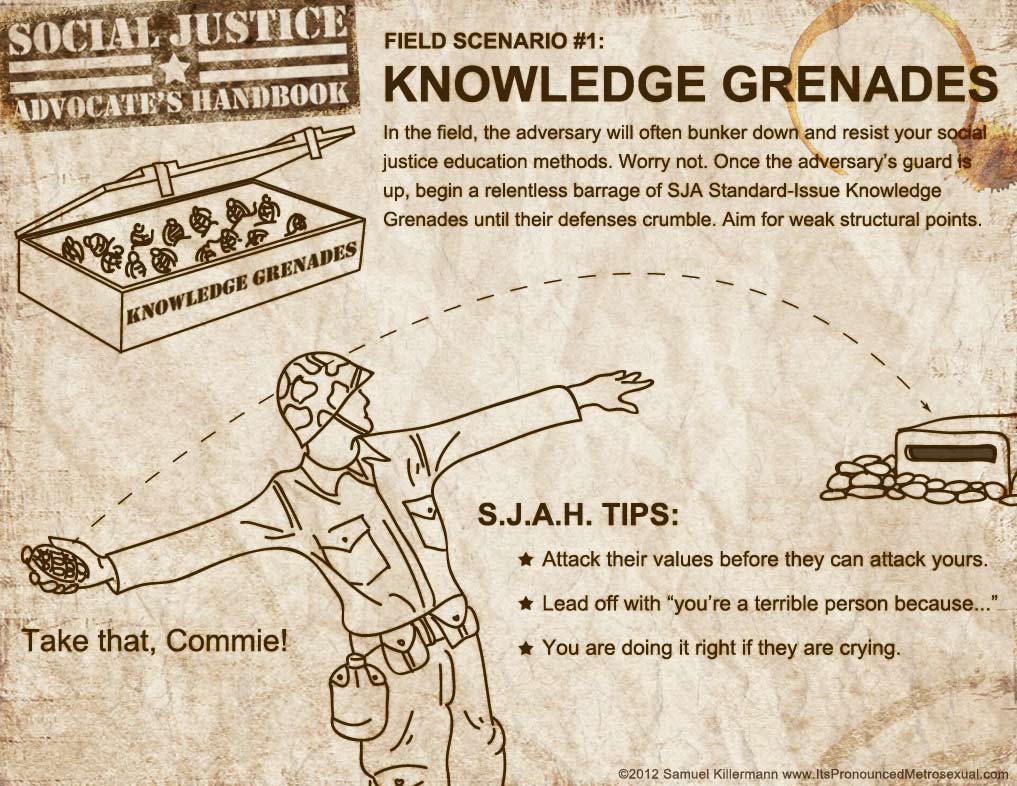The way I approach social justice and ally work on this site and in my show has a distinct flavor. Some would call it sweet, but I think ginger is a bit spicy.
I don’t often do things by accident, and in this case it is very on purpose. My flavor is even so noticeable that if you’ve seen a lot of what I’ve created here, you’re likely taken aback by the headline of this article. Well, that actually leads me into my first point.
1. I try not to talk down to people
Did the title of this article irk you a bit? It likely did. How could I possibly know that my approach is better than yours? I don’t know you. I don’t know your experiences. Nor do I know your dispositions.
I can’t know my approach is better, so why would I start the conversation out that way? Unfortunately, a lot of folks I’ve seen trying to do good start things out this way.
You can’t know what people know without asking them, so start by asking. Get a sense for what they know and attempt to build on that, don’t just assume they have everything wrong and start at square one. At the very least, people likely have a decent idea of what is wrong with society, even if they don’t know how to fix it.
An important thing to remember is that you weren’t always an “expert” on the stuff you now know so much about. In fact, it’s likely that you’ve only known it for a very short amount of time (I’m learning and relearning things every day). Try to keep that in mind when you approach someone, because it’ll help you keep yourself out of the ever-seductive ivory tower.
Icebreakers to figure out on what level to start a conversation:
- Tell me what you know about the hardships of X group.
- When in your past have you felt like life was just plain unfair?
- What’s your experience with (/knowledge of) social justice and equality issues?
2. I try to meet people where they are
Following up on the first point, I’m drawing on a phrase I learned in grad school. In trying to help people learn and grow, it’s wise to meet them where they are. That is, to use terms and concepts and ideas they are familiar with to help them begin to grasp concepts that are slightly more advanced. Nobody should start out eating a sundae; they should get a sense of what a banana and ice cream and strawberry and chocolate and peanuts taste like individually to know how much more delicious they are when you mash them all together okay now I’m hungry.
The biggest issue here is that you know 100% of an issue that your target knows (let’s be generous) 10%. And you, being a well-intentioned person, want your target to instantly go from 10% to 100%. Well, sorry friend, but that’s not how it works (and you know how I feel about well-intentioned people). Instead, try aiming for 11%. Or, if you really want to challenge them, 12%. Challenge is okay if there’s not too much. Too much and they’ll snap like a dry waffle cone. Sorry, I’m still in sundae mode.
All of the graphics and articles I create here are created with a particular knowledge level in mind. For most of what I do, that level is introductory. But in some articles, like my Sexual Orientation for the Genderqueer Person, I build on an introductory article. That’s because the goal of this site is to help people help other people with these issues, I’m not defending my dissertation on sexuality and gender (as some commenters seem to think).
Tips for meeting people where they are:
- Figure out where they are (see #1 above).
- Be patient and don’t skip steps. People may fake understanding if you go too fast, and that doesn’t help anyone.
- Think about where you were when you first confronted these issues.
3. I try not to be overbearing or aggravating
Looking back at the headline of this article, you may have been a bit pissed off when you read it. If you’re like a lot of folks, you may have started reading the article with the sole intent to find something wrong and correct/denounce it in the comments — and all this happened before you even heard what I have to say. This happens in real-life conversations all too often.
Well-intentioned people see an opportunity to educate someone on a social justice issue (e.g., they overhear the person say something homophobic) and they pounce. Before the unsuspecting student (prey) knows what’s happening, the social justice educator (predator) has ripped out their throat and is nibbling on their entrails. Yum.
Just bringing up a lot of these issues is enough to put someone on the defensive. People don’t like being attacked. When they sense that happening, they’ll prepare their defenses. Once someone is holed up in a bunker with you whipping your knowledge grenades at them, it’s guaranteed to be a long siege (once I wrote this sentence, I couldn’t resist drawing it). People don’t often change their minds on important issues by force (read up on holy wars).
Ways to avoid a social justice holy war:
- Use “I” statements whenever possible (e.g., “I use this term because” instead of “you should use this term because”).
- Dip your toes into the pool before you cannonball. It’s not good to take a potential social justice trainee (victim) by surprise.
- Know what your triggers are and how to navigate them (here’s a fantastic guide about triggers by Kathy Obear that may help).
4. I try to create cute graphics and make silly jokes
Social issues could be lightly described as hot-button issues, meaning they are likely to make calm become nuclear if pushed too hard. It’s important to be aware of this and attempt to mitigate it when you’re chatting with people about this stuff. There are a number of ways one can do this; on my site I use cute graphics, and in person I use humor.
For me, humor is the best tool for diffusing a situation. I’ve been doing it since I was just a wee little social justice educator, and it’s my main tool. In some situations, this doesn’t work that well, and there are definitely great (or better) alternatives. But I’ve learned that for my style of writing and talking, cute graphics and silly jokes work. Figure out what works for you.
The big idea here is to create a space that feels safe and welcoming for anyone you’re chatting with about social justice and equality issues. As you’ve learned above, there’s plenty stacked up against it going well. Don’t do something you’re not comfortable with (e.g., trying to be funny if you’re not, trying to be warm-hearted if you’re naturally more room temp), and experiment to find what works, just do something.
Some ways to make a space feel a bit safer:
- Respect/establish confidentiality. Ask if the person wants the talk to remain confidential, and if so, make it so (Star Trek quote!).
- If you share, they will share.
- Remind the person/group that you’re far from perfect (you aren’t), and still learning yourself (you are).
5. I try to keep trying, and keep learning
I don’t always do the things above well (or at all), but I always try to. And if one approach doesn’t work for an issue, I try another one. Trying and failing and trying again is a huge part of social justice work, and is my general approach (just read the comments of any article on this site). Knowing that I’m going to fail allows me to take risks that are necessary for me to keep growing.
If you’re “educating” people in social justice or equality issues and it turns out they know something you don’t, great! Ask questions, learn more, let them teach you. You’ll be better off for it on your next adventure, and you’ll have established a genuine trust with that group. Trying and failing often leads to learning. Let it. It’s good for you. Like aloe vera.
And above all, try to keep trying. Achieving social justice is definitely possible, but it’s not going to happen after one toss of a knowledge grenade. Keep hurling those things relentlessly! Wait — that might be bad. The point is not to give up. If you give up, the war is lost. Actually, try not to use the word “war.”
What helps me to keep on keepin’ on:
- I remind myself why I do what I do. Sometimes I do that in writing.
- I spend time with positive people and interact with others who have a similar cause.
- I save the few encouraging emails I get for when things get rough.
What are some best practices or tips I missed?
I’d love to make this into a 5+ Reasons article. Share some suggestions for social justice best practices in the comments below and I’ll add them to the list above. Or, even easier, share additional pointers for the lists within each point. And, as always, you can email me if you’d rather keep it private.


